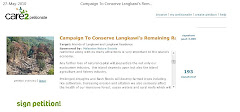Langkawi will become a State Park!!
Wow! That was a very strong and bold statement made by the Head of Jabatan Perhutanan of Langkawi (Langkawi Forestry Department), En Rashid.
That statement was made on the evening of 5th August 2010 at LADA Auditorium for an event jointly organised by Malaysian Nature Society (MNS) and Langkawi Development Authority (LADA). The attendees were from MNS, Tourist Guides Association, resorts, Taxi Drivers Association and some government agencies. Sadly, the attendance was quite poor.
There were two discussion sessions held this week. The first discussion was on the 3rd August 2010 targeted to the boat operators in Kilim Geoforest Park. The purpose of this session was to present Langkawi's natural heritage, the need for conservation and resolutions.
The speakers for those two sessions were Dato Hashim bin Abdul Wahab, Vice President of MNS and Prof Ahmad Ismail, Department of Biology, Faculty of Science UPM.
The second similar session was for the rest of the stake holders of Langkawi's tourism industry. The panel of the discussion session were Dato Hashim, Prof Ahmad, En Megat from LADA, a representative from Tourism Department and En Rashid from Jabatan Perhutanan (Forestry Department).
After the slide presentations from Dato Hashim and Prof Ahmad, the rest from the panel were given the opportunity to speak about their roles before the Q & A session started.
The most interesting part came from the Head of Forestry Department in his statement about creating Langkawi as a State Park and it is now a proposal that is in the discussion and planning stage.
A State Park. What does one understand from it?
From my layman's point of view, it would mean protection of land under the jurisdiction of the state government and no one else can touch it. Does that mean no one can touch the forest and its natural beauty? When En Rashid was asked about the priority of the state park whether it is for conservation or development, his answer was CONSERVATION. Good answer!
Now, further questions...
What about the current gazettement of Langkawi's forest reserve? Will that be altered as to increase the size of forest reserve?
Which areas would be gazetted as State Park? Kilim? Mat Cinchang?
I do hope that they will not solely focus on those Geoforest Parks above as other areas like Kuala Teriang, Gunung Raya, Bukit Sawak, Pulau Tuba, etc. are equally important for Langkawi's biodiversity.
How committed the state government can be in ensuring the State park is managed in a clean and ethical manner?
The current enforcement by Jabatan Perhutanan is in a pathetic situation. You need to first beef up your team of enforcement officers against the poachers before this State Park is turned into reality. And then... WHEN? WHEN WILL THIS HAPPEN? Next year? or next decade?
There were many good relevant questions from the attendees. One of them commented on the lack of networking between government agencies. For example, when poachers were spotted or caught, the issue will be pushed from one Jabatan (department) to another Jabatan. Oh... so true!
Someone commented on Prof Ahmad's conflicting ideas about eco-tourism and bringing buses into small kampung roads leading to the Buffalo Park. To allow buses into the Buffalo Park would mean destroying the small kampung roads. Small kampung roads are used by cycling tour operators taking tourists into rustic kampung houses, paddy fields, rubber plantations and the Buffalo Park. These are the scenic experiences that tourists are looking for and not some big roads! There are alternative means to bring in groups rather than by buses and yet maintaining the current kampung roads. Thank you to that person for reminding all of us that eco-tourism equals to minimum impact. This is what I had studied before, eco-tourism is defined as responsible travel to natural areas that conserves the environment and sustains the well being of local people. In layman's term, controlling the number of people going into an area according to the sensitivity of the eco-system means lesser the impact to the surrounding. Simple equation!
A representative from the Taxi Association brought up about alternative to using petrol like LPG. Applaud to him!! Instead, the answers given to him was about this and that policies with such and such company... aiyo, I felt his frustrations too..
En Megat from LADA pointed out that there was lack of support and participation from the local born and breed Langkawians themselves. He was right. In that auditorium, more than 90% were locals from other states. Most of the Langkawi's conservation and green issues were raised by locals from other states and the Mat Sallehs (expatriates). Where are the local Langkawians? The vibes that I got at the end of his comment was:
"Please give us solutions. If the rakyat are not interested, this is as much we can do."
And... I just thought of this. One of the solutions will be making strong commitment in educating the young Langkawi kids. It is time for LADA or any other organisation to think about setting up a proper fully funded nature education center with trained and passionate facilitators instead of developing more buildings or resorts.
After sitting in the auditorium from 8:30pm to 11:00pm, the next question will be SO WHAT NEXT? What are their action plans?
That question was answered by Dato Hashim as his conclusion. After all his ramblings that went round the circle on the conclusion, it seemed to me that there was no definitive plan or was it just too late at night for me? Another wait-and-see game? Or one is waiting for the other hand to clap?
These two events are a good start towards protecting Langkawi's natural heritage. We look forward to the next actions, commitments and more participation from the local Langkawians. Many thanks to Jimmy, MNS-UNDP and En Megat, LADA for bringing this together.
Link:
1. UNTAMED Path.com: Defining Eco-Tourism
... Read full post ...

































